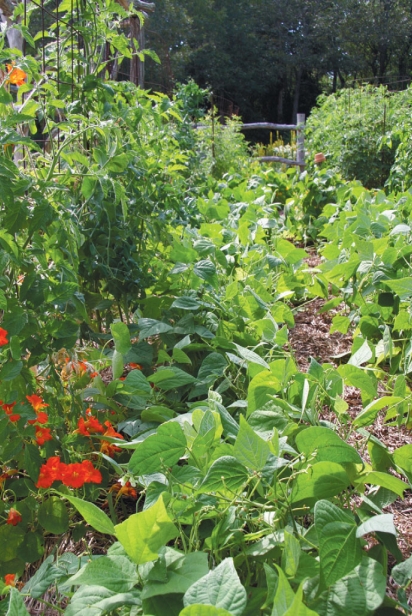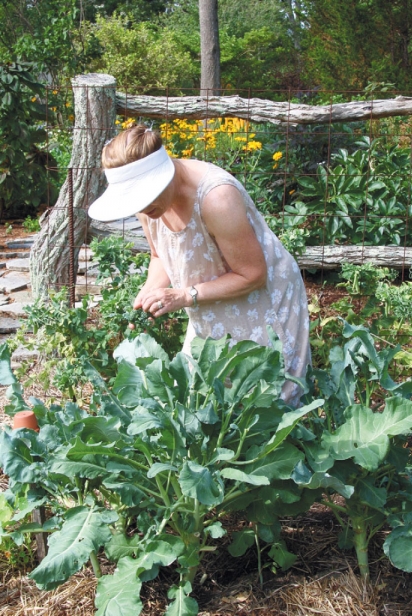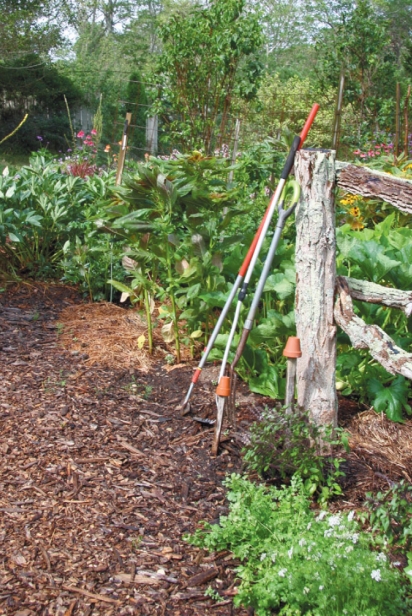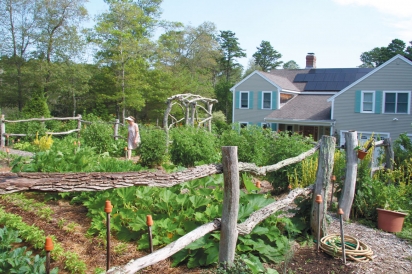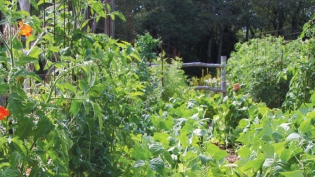In the Garden with C.L. Fornari
Cape Cod gardening legend C. L. Fornari and I are sitting behind her house at Poison Ivy Acres on a stone patio surrounded by flowers. It has not rained in weeks and an overcast sky is teasing us with the hint of possible showers. Before us are trees and a stand of blueberry bushes. We can just see a pond, where my ten-year-old aspiring journalist son splashes along the shoreline with our dogs in hot pursuit.
Although Fornari is currently marking her ninth summer on Poison Ivy Acres, the name is misleading. Her home is in fact two-and-half acres of beautifully cultivated land on a downward slope toward Lawrence Pond in Sandwich. This is where the well-known gardening expert, author, and radio host finds inspiration and connection to the natural world, and where, on a hot and cloudy July day, she shared insightful knowledge gathered from years of experience cultivating flowers and produce in our unique Cape Cod environment.
Fornari tells me it took considerable time for her and her husband Dan to find this spot, and when they did, it was a lawn with three hydrangeas and two perennials. “That was it, everything here we put in, the veggies in the front yard and the locust trees, and we built the fence,” she said.
“Growing veggies is one of our great pleasures. We have this garden here and less than a mile away we have 40x40 plot at the Marstons Mills community garden,” she said.
She describes gardening as a lifelong passion. “I’ve always been attracted to plants. When I was a kid parents pushed kids outside and told us not to come back until dinner. So we had to make our own fun. We picked neighbors’ flowers and sold them back to them, we made chains out of flower blossoms, and a lot of our entertainment involved plants. In college I started growing house plants, and herbs on the windowsill, and in 1972 Dan and I started our first vegetable garden in California.”
Fornari has also gardened in New York’s mid-Hudson valley, and she gardened at the community garden through the 15 years she lived in Osterville with too little space for her own plot at home. “One of the prime motivators for moving [to Poison Ivy Acres] was putting the vegetable garden on our own property. We didn’t want to have to drive to pick a handful of beans,” she said.
“The produce we grow is mostly for ourselves, we mainly share it with friends, and we donate a lot to the soup kitchen at the Salvation Army,” Fornari said. She prefers to use her freezer for winter preservation.
A breeze kicks up through the heat and the first raindrops finally fall from the overcast sky, threatening the ruin of my notebook. We decide to take cover, but first we walk down to the pond to retrieve the boy and the dogs. We pass the blueberry stand.
“There are fifteen blueberry bushes, and they need to be netted to keep the birds out. I wouldn't mind sharing with a few small birds, but the geese can take out all the fruit in a few hours. One night all the blueberries vanished, and there was goose poop everywhere, so we knew,” she said.
We finally find shelter from the rain on the other side of the house on the covered front porch. The vegetable garden is before us and while there are no dogs allowed, Fornari sends my ten-year-old in with a basket.
“We have more sugar snap peas than humans should have,” she said as he scrambles to pick them. “We eat them fresh with hummus as a dip, in salads, in stir fry, and with pasta tossed with salt and pepper and garlic. They’re fantastic,” she said.
As the rain drizzles, we munch crisp sweet sugar snap peas while Fornari considers the biggest problems Cape Cod gardeners have growing vegetables. “The biggest threat to tomatoes is early blight. It’s a fungus, causing the plants to get black spots and yellow leaves from the bottom up. It’s very difficult to avoid, but there are strategies that allow you to grow tomatoes all season and have a good harvest,” she said.
One such strategy is mulching. “Mulch around the plants as soon as you plant them. You can use hay, chopped up leaves, black mulch, or salt marsh hay. We have hay mulch I get from Country Garden at the end of the season when it’s leftover,” she said.
Another strategy is weekly spraying with an organic fungicide. “Several fungicides are available at garden centers. We use Serenade right now, but we have used others as well. Fungicides suppress early blight enough to get a good crop all summer long,” she said. Watering appropriately can also help. “Water in the morning whenever possible, and water deeply but less often,” she said.
As our basket of sugar snap peas dwindles, my son is sent off just to the right of the vegetable garden, a little bit uphill to a patch of raspberries. I’ve seen him take notes, but so far fieldwork is his favorite part of journalism.
Fornari discusses another problem common to Cape Cod gardens: insects. “Be prepared to notice and treat early for insects. A common product for fighting insects is diatomaceous earth, which is good for organic vegetable garden insect treatment and which gardeners should always have on hand.”
She emphasizes an avoidance of pesticides, and her fungicide and insecticide are organic. “That’s important as it doesn’t kill off good insects as well as bad ones. When you start poisoning the earth, you upset the natural balance of nature and the balance of predator to prey,” she said.
Growing conditions on Cape Cod are unique, Fornari said, because of our climate. “We have a long growing season. The spring starts out cold but it stays warm through October, and it’s not too excessively hot, which is good as well,” she said.
These conditions support some vegetables better than others, and Fornari was happy to list a few varieties that flourish on Cape Cod. “Virginia Sweet and Mountain Magic are the most early blight-resistant tomatoes,” she said. She advises gardeners to stay away from heirloom tomatoes as they do not produce in large volume and they are the first to die from early blight.
“The most mildew resistant summer squash is Zephyr Costata Romanesco. It has a long harvest through October, and the best kale to grow on Cape Cod is Tuscan kale, or Dinosaur kale or Lacinato kale. I would not be without it. You can eat it at four inches and we harvest it through the new year. Kale is one of my must-have plants,” she said.
Fornari continued, sharing two very important things every Cape Cod gardener should know. The first is that raised beds do not have to be raised. “The principle of raised beds is that soil should be loose and very well amended, and you don’t want to walk on it. That can be raised up, but it doesn’t have to be. You can do the same thing on the ground if it’s well amended and loose, which allows you to grow more plants faster in one space.”
The second thing every Cape Cod gardener should know surprised me: It’s a myth that marigolds keep out insects. “I debunked that myth in my book Coffee For Roses. The myth came from an extension service study done in the south about keeping the pest soil nematodes away. The study showed farmers’ fields that had been planted with marigolds had suppressed levels of nematodes. This information about nematodes in southern fields and marigolds started the rumor. Marigolds do not keep insects out of the garden.”
As the rain slows, we leave our chairs and walk up stone stops to enter the garden. Fornari hands my son a paper Trader Joe’s bag and we pass what she calls annual alley, a burst of color she compares to a new box of crayons every year. We begin to forage and are confronted with a row of blooming nasturtiums. “One of the top edible plants. Beautiful and delicious,” Fornari declares. She hands me a leaf and a flower. The leaf has a peppery strong flavor. The flower is peppery and sweet.
“The leaves make great wraps and roll ups. We fill them with goat cheese and hummus and roll them. We eat them in salad every night. They are a must have,” she said.
Tall Verbascum spikes the landscape, drawing the buzzing bees. We find rows of spicy arugula hiding under growing squash leaves. Bundles of it join the nasturtiums already in the bag my son carries.
There are neat rows of Tuscan kale, leeks, eggplant, peas and broccoli. I see that for all the sugar snaps we have consumed, many, many more remain.
Fornari tells us that the garlic has been harvested and leads us to a drying shed. She plants the garlic in October for harvest in July. We find the harvested garlic is laid out to dry and it smells like an Italian feast. She hands my son a bunch and with their stems attached they are as tall as he is. The garlic will flavor the vinaigrette with which he is planning to dress our dinner salad.
Fornari’s seventh book The Cocktail Hour Garden: Creating Evening Landscapes for Relaxation and Entertaining came out last April, and it sums up the atmosphere of her garden. The book is about creating a landscape for the evening at a time when people benefit from reconnecting to the natural world.
“The genesis of the book was sitting on the back deck. My husband Dan and I work very hard, but when we moved here, we developed the ritual of stopping at 6 pm and sitting down to look at the landscape. That’s what a lot of us forget to do. We forget to sit and watch what is going on in our own backyard. It’s about connecting to the landscape to appeal to all of our senses—the herbs that are fragrant, the snap peas from the vine for hors d'oeuvres, the sprig of verbena in a drink, watching as the sky turns color and listening as the birds sing. It’s an instant lowering of the blood pressure as you see the life that goes on in your garden,” she said.
C.L. Fornari hosts two different radio shows: WXTK Cape Cod and Southeast Mass from 8-10 am on Saturday morning, or The Garden Lady on WRKO Boston from 12-2 pm on Saturday afternoon. Find her blog at gardenlady.com.



